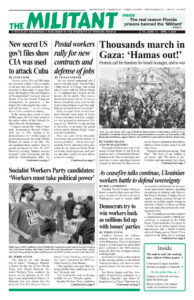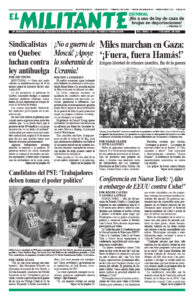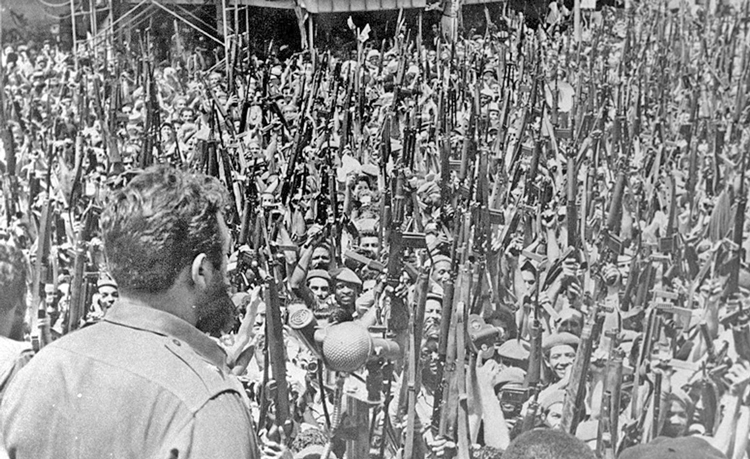The role of the CIA and FBI under the capitalist system is shown clearly in the activities they carried out documented in thousands of pages filed under the heading of the assassination of President John F. Kennedy released March 18 by the Donald Trump administration. In particular, it has helped fill in the lengths they went — and still do today — to try to bring down Cuba’s socialist revolution.
In the coming days, a total of some 80,000 pages will have been posted on the public website of the National Archives Records Administration.
Congress passed the “John F. Kennedy Assassination Records Collections Act” in 1992, leading to the declassification of 5 million pages of government records, but many of them blacked out much of the files. The act mandated those sections must be posted unredacted by Oct. 26, 2017. However, claiming “national security interests,” under Democratic and Republican administrations alike, the government delayed compliance, with few exceptions, until now.
While many liberals and conspiracy theorists had hoped for revelations of a wide sweep of forces involved in the assassination, or evidence Fidel Castro was somehow involved, they were disappointed.
“The final revelations in the documents turn out to be the CIA’s most guarded of secrets: sources and methods, agent identities and global targets,” writes Peter Kornbluh in the Nation magazine. He is a senior analyst at the National Security Archive and editor of Bay of Pigs Declassified. “The unredacted documents name names — of officials, operatives, assets, informants and collaborators.
“Those operations include how the CIA manipulated elections in numerous nations, sabotaged economies, plotted to kill foreign leaders and overthrew undesirable governments abroad — while also busily conducting illegal operations at home.”
Attacks on Cuban Revolution
Havana has long pointed to acts of aggression by Washington and its secret police agencies against the Cuban Revolution and Fidel Castro. The U.S. rulers will never forgive the Cuban people for overthrowing the U.S.-backed Fulgencio Batista dictatorship in 1959, and nationalizing industry, land and other businesses to be run by working people.
While the fact these attacks took place has been known for decades, the newly released documents confirm, in the CIA’s and Kennedy administration’s own words, how some of these operations were planned and carried out.
For example, documents “detail a yearslong campaign of CIA-sponsored sabotage and assassination attempts targeting Castro,” with the help of the “American Mafia,” a Wall Street Journal reporter who studied them says.
An Aug. 18, 1964, document reads: “Prices allegedly agreed upon were $100,000 to assassinate Fidel CASTRO; $20,000 for Raul CASTRO; and $20,000 for ‘Che’ GUEVARA.”
Another document, dated Nov. 12, 1963, says the CIA planned to plant bombs in Havana’s sewage system set to explode during a speech by Fidel Castro to the Committees for the Defense of the Revolution.
In 1961 the Kennedy administration launched “Operation Mongoose,” plans for sabotage, subversion and preparation for U.S. military intervention.
“William King Harvey was the CIA’s point man for Operation Mongoose, an assassination plot to remove Fidel Castro,” writes James Robenalt in Vanity Fair. “The plan traces back to the Eisenhower administration and eventually involved Attorney General Robert F. Kennedy.”
A 1962 memo on one CIA plan to assassinate Fidel Castro using poison pills reads, “Harvey passes the pills to ROSELLI [a member of Chicago mafia] in Florida. Roselli was to give the pills to Varona [Cuban counter-revolutionary Tony Varona in Miami], who had an asset in Cuba with access to Castro’s restaurant.”
Another memo on July 1, 1963, says that “two leaders of the Cuban Exile Group” were coming to Washington, D.C., to “confer with CIA and other Government officials, including probably Robert F. Kennedy, the Attorney General, concerning the ‘new program’” i.e., further efforts at invasion or other attacks, “for the exiles.”
According to Kornbluh, the records show evidence that intelligence agencies in several countries — Canada, Britain, the Netherlands, France, Spain, Italy, Israel, Greece, Norway, Denmark, Germany, Mexico, Argentina, Uruguay and Chile — assisted CIA operations aimed at overthrowing the Cuban government.
The Cubans were aware of these campaigns. In the autobiographical interview with Fidel Castro by journalist Ignacio Ramonet, published in English as My Life, Castro said, “From November 1961, after Playa Girón to January 1963, that is, in fourteen months, there were a total of 5,780 terrorist actions against Cuba, and of those, 717 were serious attacks against our industrial facilities.
“As a result of this activity, 234 people in Cuba died. That terrorism, in total, produced more than 3,500 victims, more than 2,000 people mutilated. Cuba has had to face more terrorism than practically any other country on earth.”
To the chagrin of conspiracy theorists, there is no evidence in any of the documents that Castro or the Cuban government had any connection with Lee Harvey Oswald, who assassinated Kennedy in 1963. A multiyear CIA investigation found “no definitive proof that the Castro regime was implicated.”
In My Life, Castro says, “Thank goodness we didn’t give that guy permission to visit Cuba. That would have been a tremendous manipulation, a tremendous provocation, because they could have used that to implicate Cuba.
“Actually, when the investigation was being carried out,” Castro said, “we gave them all the information we had.”
In addition to information related to Cuba, a memorandum by an aide to Kennedy stated that nearly half of the political officials in American embassies worldwide were working for the CIA. Unredacted documents were released showing CIA operations against other governments.
“The documents also expose how the CIA financed and orchestrated the 1966 election of its chosen coup-plotting military man, Gen. René Barrientos in Bolivia,” Kornbluh writes.
“They record in greater detail than previously understood how agency operatives financed — at $10,000 a day — street protests in British Guiana that pushed the liberal government of Cheddi Jagan from power in late 1964.”


